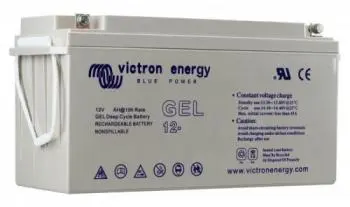
Gel batteries are one of the most popular and reliable options in solar energy systems.
These types of batteries, which use an electrolyte in gel form instead of liquid, have gained ground in solar applications due to their unique characteristics that make them suitable for storing electricity generated by solar panels.
What are gel batteries?
Gel batteries are a type of rechargeable battery that uses an electrolyte in gel form instead of liquid.
This gel is composed of sulfuric acid, water and silica, and is thicker than the liquid electrolyte used in conventional lead-acid batteries. The gel acts as a medium to transport electrical charges between the battery's electrodes.
How do gel batteries work?
A gel battery works by using a gel electrolyte instead of a liquid electrolyte, as in conventional lead-acid batteries. The gel is a viscous material that contains sulfuric acid, water and silica, and acts as an ion conductor.
During charging, an electrical current is applied to the battery, causing a chemical reaction in the gel. Positive ions move from the negative electrode to the positive electrode through the gel, while electrons flow in the opposite direction, thus charging the battery and storing energy in the form of chemical energy.
During discharge, when a device is connected, the ions move back through the gel, releasing electrons and generating an electrical current that powers the device, converting the chemical energy back into usable electrical energy.
Advantages
1. Low self-discharge rate
One of the most notable advantages of gel batteries is their low self-discharge rate. This means they retain their charge for a longer period without needing constant recharging.
Compared to conventional lead-acid batteries, gel batteries are ideal for long-term storage applications, making them a solid choice for solar energy systems.
2. Safety and maintenance free
Gel batteries are sealed and airtight, significantly reducing the risk of corrosive acid leaks. This makes them safer and easier to handle, without the need for regular maintenance, such as adding distilled water, which is common with conventional lead-acid batteries.
No maintenance reduces costs over the life of the battery.
3. Vibration resistant
Due to their sealed construction and gel electrolyte, gel batteries are resistant to vibrations and shocks. This makes them suitable for mobile applications, such as caravans, boats and recreational vehicles, where batteries may be subject to constant movement and shaking.
4. Wide operating temperature range
These batteries are capable of operating efficiently in a wide range of temperatures, making them suitable for various weather conditions. They can withstand both extremely cold and hot temperatures without losing their efficiency.
5. Long service life
When properly maintained and used, gel batteries have a reasonably long lifespan. Their ability to withstand repeated charge and discharge cycles makes them ideal for deep cycle applications, such as solar energy systems that require regular discharge.
Disadvantages
Despite their many advantages, gel batteries also have some disadvantages:
1. Lower energy density
Compared to lithium-ion batteries, gel batteries have a lower energy density, meaning they take up more space per unit of capacity. This can be a limitation in applications where space is critical.
2. Higher initial cost
The initial cost of gel batteries is usually higher compared to conventional lead-acid batteries. However, this cost can be offset over the life of the battery due to its durability and lack of maintenance.
3. Lower charging efficiency
Gel batteries may have slightly lower charging efficiency compared to other battery technologies, meaning they may require longer to fully charge.
Applications in photovoltaic systems
Gel batteries are used in a variety of applications in solar energy systems, including:
1. Residential energy storage
In residential solar power systems, gel batteries store excess energy generated by solar panels during the day for use at night or on cloudy days. This allows homeowners to maximize self-consumption of solar energy and reduce dependence on the conventional electrical grid.
2. Autonomous solar energy systems
In remote areas or where there is no access to the electrical grid, gel batteries are essential for off-grid solar energy systems. These systems use solar energy as the primary source and store the electricity in gel batteries for continuous use, even when the sun is not available.
3. Power backup systems
Gel batteries are also used in solar power backup systems. In the event of a power outage, these batteries provide backup power to keep critical devices running, such as lights, refrigerators, and security systems.
4. Mobile applications and transportation
Gel batteries are used in vehicles, boats, and mobile power systems due to their ability to resist vibrations and shock, as well as their ability to operate in various weather conditions.